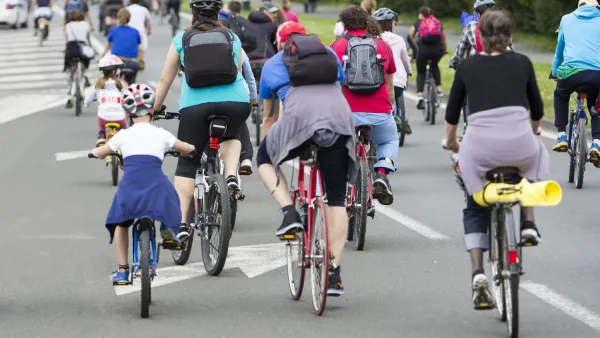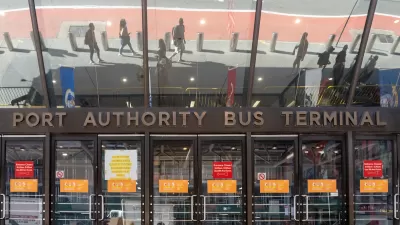The epic, years-long battle for converting one Holland Tunnel tube to a bicycle/pedestrian-only facility may find compromise in this proposed free ticket voucher program for bicycle-toting ferry passengers.
I'm all about compromise; that's why after conversations with some enlightened individuals, I have decided to magnanimously ease my hard line with the Port Authority NY/NJ about converting one of the Holland Tunnel tubes to a bicycle/pedestrian-only facility. I still think the world would be a better place if we reduced capacity for automobiles into Manhattan while simultaneously increased ease of access for non-motorized transport (NMT), but for some odd reason not everyone always sees things the same way I do. As an alternative, I am now rethinking my position and willing to consider an option that I learned about while visiting Amsterdam recently, but with a twist. The idea, basically, is to subsidize bicycle passenger trips on existing ferry systems so that travel with a bicycle across the Hudson River is free for users.
In case you didn't know, I take every opportunity I get with PANYNJ officials to ask when they are going to convert one of the Holland Tunnel tubes for pedestrian/bicycle use. This, of course, gets all kinds of chuckles – and is a great boost to my self-esteem – but the economic and health impacts to both states and the region is no laughing matter. We have seen time and again that providing local connectivity has many benefits, and I argue when these facilities bridge "transportation canyons", it can be even more beneficial. Alas, we've been at loggerheads for years (read: non-starter and me, pariah) and so perhaps some fresh thinking is needed.
Fortunately, I'm not alone in my ideals, and a recent nudge by like-minded individuals reminded me of a free ferry service the City of Amsterdam offers between the city central station and northern residential communities. Something along those lines would strongly encourage bicycling between New Jersey and New York City, and more importantly for those watching events unfold in international media coverage, end the years-long stand-off between myself and PANYNJ on this issue.
The idea jives well with the strong existing ferry service fleet provided by the innovative and community-oriented company NY Waterway. NY Waterway actually already accepts bicycle-toting passengers, but the economics are inverted because it is market-driven, as opposed to incentive-driven. At the moment, NY Waterway is "bicycle-friendly", but charges for the extra baggage, since they are not in the business of promoting bicycling as a public benefit. That, of course, is the obligation of government.
To take a bicycle on the NY/NJ ferry there is currently an additional $1.00 fee on top of the standard ticket price. This makes business sense, but it further discourages bicycling, and as I have mentioned before, the only other bicycle connection is a 13 mile ride up to the George Washington Bridge and then back down. Given the dearth of shower facilities in New York City office buildings, only truly heroic riders will venture this feat on a regular basis, if ever, and others in the office are probably better off for it. However, what if NY Waterway were able to offer free ferry service to anyone arriving at their terminals with a bicycle? We all know how free can persuade people to change their habits, and if there was a free commuting option to Manhattan, who can doubt that many people would take up that offer, at least occasionally?
It works like this: PANYNJ issues a program-limited number of one-way "bicyclist" ticket vouchers to NY Waterway, thereby capping the budget allocated for this program. When a rider arrives at the terminal with bike in tow, the cashier issues a free one-way "bicyclist" passage ticket, which is then handed to ferry staff and subsequently voided when boarding. Bicyclists must board and alight the ferry last, since they interfere with fast and efficient activity of other passengers (hey, it's free!). There is also a physical limit to the number of bikes any ferry can handle, so there may be a wait for the next ferry to arrive during busy periods, but ferry frequencies during peak periods are high, and a bicycle rider can more easily choose, for example, between World Financial Center or Midtown ferry terminals because in many cases the bicycle trip time in Manhattan will not be much different (a spin down Hudson River Park bicycle-way is no more than five to ten minutes between the two terminals). Bicyclist tickets collected by NY Waterway are then remitted to PANYNJ who in turn reimburses NY Waterway $1.00 for every bicyclist ticket collected. If NY Waterway previously had a single bicycle rider, on average, using their boats, they could match the lost passenger fare by accepting 8 "free" bicycle passengers per boat (standard $7 fare + $1 bike surcharge). But bicycle transport on the ferries is arguably much lower - perhaps there is only 1 bicycle for every third or fourth boat on average - so a 1:8 ratio is not realistic; it is probably more like 1:3. In other words, if NY Waterway manages to carry more than three bicycles per boat on average, there is a new - albeit small - revenue stream realized, while simultaneously introducing their service to new customers. The system also encourages NY Waterway to be creative about stowing bicycles so that they can build bicycle ridership beyond the average 1:3 ratio.
The result is that NY Waterway can fill gaps in capacity and introduce new customers to their ferry service, who may occasionally travel without their bike when they previously would not take the ferry at all. Sure, they don't collect the standard passenger fare for those bicycle-toting passengers, but those were likely new trips that would otherwise not have traveled on their boats anyway, so it's not really lost revenue. And the 1:3 ratio is likely very easy to meet given the service would be free.
For PANYNJ, they piggy-back on an existing transportation facility to provide an excellent (and opportunely popular I might add) community benefit for an extremely low annual cost. If you assume the program encourages 100 new daily "bicyclist" ferry passengers, for a total of 200 new daily trips, the annual total "bicyclist" ridership would be about 50,000. Imagine encouraging 50,000 new bicycle trips per year to/from New York City costing just $50k; that's a drop in the PANYNJ budget! And even if it were double or triple that estimate, the expanded use of ferries on the Hudson River is an excellent release valve to the pressures other travel modes are experiencing at, I would argue, a fraction of the cost of increased capacity solutions to subway and tunnels/bridges.
All this, and no one has to give up a tunnel tube or build a new facility; I can go back to farming, and put an end to the revolution. The only thing better would be the "Span-Hudson Zip Line" commuter proposal….

Planetizen Federal Action Tracker
A weekly monitor of how Trump’s orders and actions are impacting planners and planning in America.

Restaurant Patios Were a Pandemic Win — Why Were They so Hard to Keep?
Social distancing requirements and changes in travel patterns prompted cities to pilot new uses for street and sidewalk space. Then it got complicated.

Map: Where Senate Republicans Want to Sell Your Public Lands
For public land advocates, the Senate Republicans’ proposal to sell millions of acres of public land in the West is “the biggest fight of their careers.”

Maui's Vacation Rental Debate Turns Ugly
Verbal attacks, misinformation campaigns and fistfights plague a high-stakes debate to convert thousands of vacation rentals into long-term housing.

San Francisco Suspends Traffic Calming Amidst Record Deaths
Citing “a challenging fiscal landscape,” the city will cease the program on the heels of 42 traffic deaths, including 24 pedestrians.

California Homeless Arrests, Citations Spike After Ruling
An investigation reveals that anti-homeless actions increased up to 500% after Grants Pass v. Johnson — even in cities claiming no policy change.
Urban Design for Planners 1: Software Tools
This six-course series explores essential urban design concepts using open source software and equips planners with the tools they need to participate fully in the urban design process.
Planning for Universal Design
Learn the tools for implementing Universal Design in planning regulations.
Heyer Gruel & Associates PA
JM Goldson LLC
Custer County Colorado
City of Camden Redevelopment Agency
City of Astoria
Transportation Research & Education Center (TREC) at Portland State University
Camden Redevelopment Agency
City of Claremont
Municipality of Princeton (NJ)






























